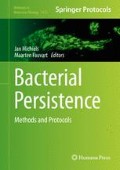Abstract
The present method quantifies the number of slow-growing bacteria leading to antibiotic persistence in a clonal population. First, it enables discriminating between slow growers that are generated by exposure to a stress signal (Type I persisters) and slow growers that are continuously generated during exponential growth (Type II persisters). Second, the method enables determining the amount of slow growers in a culture.
Access this chapter
Tax calculation will be finalised at checkout
Purchases are for personal use only
References
Bigger J (1944) The bactericidal action of penicillin on staphylococcus pyogenes. Ir J Med Sci 19(12):585–595
Hobby GL, Meyer K, Chaffee E (1942) Observations on the mechanism of action of penicillin. Exp Biol Med 50(2):281–285
Lewis K (2007) Persister cells, dormancy and infectious disease. Nat Rev Microbiol 5(1):48–56
Fridman O, Goldberg A, Ronin I et al (2014) Optimization of lag time underlies antibiotic tolerance in evolved bacterial populations. Nature 513(7518):418–421. doi:10.1038/nature13469
Balaban NQ, Merrin J, Chait R et al (2004) Bacterial persistence as a phenotypic switch. Science 305(5690):1622–1625. doi:10.1126/science.1099390
Gefen O, Balaban NQ (2009) The importance of being persistent: heterogeneity of bacterial populations under antibiotic stress. FEMS Microbiol Rev 33(4):704–717, doi: FMR156 [pii] 10.1111/j.1574-6976.2008.00156.x
Levin-Reisman I, Gefen O, Fridman O et al (2010) Automated imaging with ScanLag reveals previously undetectable bacterial growth phenotypes. Nat Methods 7(9):737–739. doi:10.1038/nmeth.1485
Michel JB, Yeh PJ, Chait R et al (2008) Drug interactions modulate the potential for evolution of resistance. Proc Natl Acad Sci U S A 105(39):14918–14923
Levin-Reisman I, Fridman O, Balaban NQ (2014) ScanLag: high-throughput quantification of colony growth and lag time. J Vis Exp (89). doi: 10.3791/51456
Guillier L, Pardon P, Augustin JC (2006) Automated image analysis of bacterial colony growth as a tool to study individual lag time distributions of immobilized cells. J Microbiol Methods 65(2):324–334
Acknowledgments
The work was supported by the European Research Council (Starting Grant no. 260871) and the Israel Science Foundation (no. 592/10). I.L.R. acknowledges support from the Maydan Foundation.
Author information
Authors and Affiliations
Corresponding author
Editor information
Editors and Affiliations
Rights and permissions
Copyright information
© 2016 Springer Science+Business Media New York
About this protocol
Cite this protocol
Levin-Reisman, I., Balaban, N.Q. (2016). Quantitative Measurements of Type I and Type II Persisters Using ScanLag. In: Michiels, J., Fauvart, M. (eds) Bacterial Persistence. Methods in Molecular Biology, vol 1333. Humana Press, New York, NY. https://doi.org/10.1007/978-1-4939-2854-5_7
Download citation
DOI: https://doi.org/10.1007/978-1-4939-2854-5_7
Publisher Name: Humana Press, New York, NY
Print ISBN: 978-1-4939-2853-8
Online ISBN: 978-1-4939-2854-5
eBook Packages: Springer Protocols

